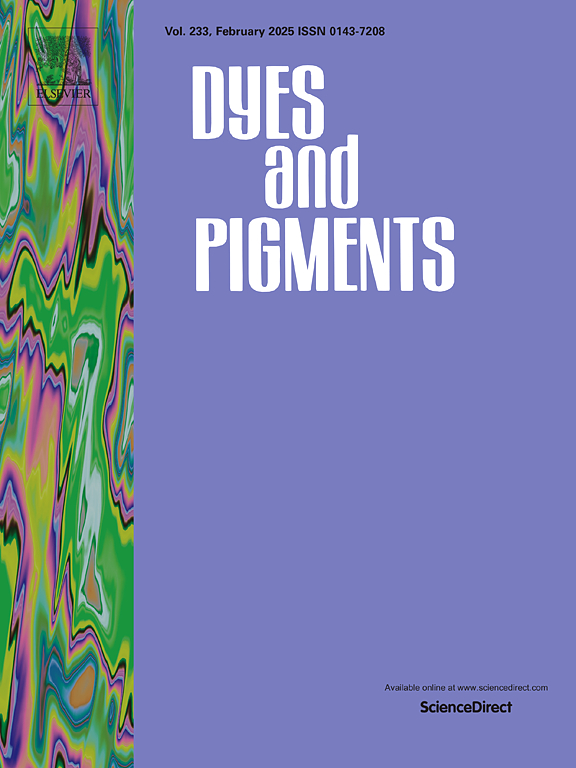含单吡啶取代苯基吡啶配体的光致发光铱(III)配合物:合成、电化学和光物理性质及电致发光性能
IF 4.1
3区 工程技术
Q2 CHEMISTRY, APPLIED
引用次数: 0
摘要
电致发光(ELC)材料可以通过电刺激实现光致发光调制,在先进的光电应用中具有重要的前景。本文合成了两种新型的单吡啶修饰环金属化配体铱(III)配合物,并对其进行了表征。研究了它们的电化学行为和光物理性质。这两种配合物在约−1.0 V vs SCE下均表现出可逆的吡啶基还原偶,并在光激发下表现出强烈的橙红色光致发光。这两种配合物都表现出ELC特性,其发射波长可通过电刺激调制。化学和电化学还原显示了显著的蓝移,可达66 nm,并伴有发射寿命的实质性变化。观察到的可逆发射位移归因于氧化还原诱导的几何和电子结构修饰,这改变了发射态的性质。一个概念验证型三明治型ELC器件演示了电压驱动的光致发光在红色(627 nm)和黄色(579 nm)发射之间切换,在20个操作周期内,在17秒内实现了90%的响应效率,具有出色的可逆性。为了展示实用潜力,制作了丝网印刷的双色信息记录装置,在电气控制下显示可逆的红到黄转换。这些发现强调了所开发的铱配合物用于动态信息显示系统和可重写光学记录技术的可行性。本文章由计算机程序翻译,如有差异,请以英文原文为准。

Photoluminescent iridium(III) complexes with mono-pyridinium substituted phenylpyridine ligands: synthesis, electrochemical and photophysical properties, and electroluminochromic performance
Electroluminochromic (ELC) materials, which enable photoluminescence modulation through electrical stimuli, hold significant promise for advanced optoelectronic applications. In this study, two novel iridium (III) complexes featuring mono-pyridinium modified cyclometalated ligands were synthesized and characterized. Their electrochemical behavior and photophysical properties were investigated. Both the complexes showed reversible pyridinium-based reduction couples at ca. −1.0 V vs SCE, and exhibited intense orange-red photoluminescence upon photoexcitation. Both the complexes exhibit ELC properties, with their emission wavelengths modulated by electrical stimuli. Chemical and electrochemical reduction revealed a notable blue shift of up to 66 nm accompanied by substantial variations in emission lifetime. The observed reversible emission shifts were attributed to redox-induced geometric and electronic structural modifications, which altered the nature of the emissive states. A proof-of-concept sandwich-type ELC device demonstrated voltage-driven photoluminescence switching between red (627 nm) and yellow (579 nm) emissions, achieving >90 % response efficiency within 17 s over 20 operational cycles with excellent reversibility. To showcase practical potential, a screen-printed dual-color information recording device was fabricated, exhibiting reversible red-to-yellow color transitions under electrical control. These findings underscore the viability of the developed iridium complexes for dynamic information display systems and rewritable optical recording technologies.
求助全文
通过发布文献求助,成功后即可免费获取论文全文。
去求助
来源期刊

Dyes and Pigments
工程技术-材料科学:纺织
CiteScore
8.20
自引率
13.30%
发文量
933
审稿时长
33 days
期刊介绍:
Dyes and Pigments covers the scientific and technical aspects of the chemistry and physics of dyes, pigments and their intermediates. Emphasis is placed on the properties of the colouring matters themselves rather than on their applications or the system in which they may be applied.
Thus the journal accepts research and review papers on the synthesis of dyes, pigments and intermediates, their physical or chemical properties, e.g. spectroscopic, surface, solution or solid state characteristics, the physical aspects of their preparation, e.g. precipitation, nucleation and growth, crystal formation, liquid crystalline characteristics, their photochemical, ecological or biological properties and the relationship between colour and chemical constitution. However, papers are considered which deal with the more fundamental aspects of colourant application and of the interactions of colourants with substrates or media.
The journal will interest a wide variety of workers in a range of disciplines whose work involves dyes, pigments and their intermediates, and provides a platform for investigators with common interests but diverse fields of activity such as cosmetics, reprographics, dye and pigment synthesis, medical research, polymers, etc.
 求助内容:
求助内容: 应助结果提醒方式:
应助结果提醒方式:


